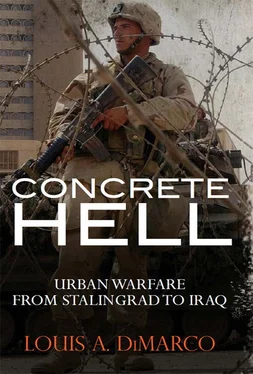The US Army took 19 days to capture Aachen and its 20,000 remaining inhabitants. The 30th and the 1st US Infantry Divisions captured approximately 12,000 prisoners. Though no accurate count of German casualties was possible, they were certainly in the area of 15,000 in addition to those taken prisoner — casualties in the 3rd Panzer Grenadier Division alone were at least 3,000. Over 20 different German infantry and panzer battalions were used in futile counterattacks to retake lost ground and push the Americans back across the Wurm River. During the battle the US artillery fired an average of 9,300 artillery rounds a day and the Germans were estimated to have used 4,500 rounds a day. American losses were significant: the 30th Division suffered approximately 3,000 casualties in 19 days of combat, roughly 20 percent of the division strength but almost a third of the division’s infantry strength. Aachen was an important battle in which, ironically, both sides achieved their objectives. The Germans had managed to keep the Americans from capturing the city for almost three weeks, until nearly the end of October, and protected their ability to stage for the coming counteroffensive — the Battle of the Bulge. The Americans were able to take the city, breach the West Wall, and secure a start position for their final offensive into Germany and across the Rhine River.
Aachen demonstrated and validated many important lessons regarding conventional urban combat. Many of the issues illustrated at Aachen were identical to characteristics of urban warfare highlighted in the earlier Stalingrad battle. Aachen validated the important role of the fight outside the city to the fight inside the city; like Stalingrad, the decisive operations occurred well outside the city, making the final reduction of the city center somewhat anticlimactic. The battle validated the critical role of armor in urban warfare — tanks were a key element in all operations. The US infantry always attacked with tank support. The only serious threats to US domination of the battlefield came from the various German armor units thrust into the battle by the German LXXXI Corps. The Tiger tanks of the 506th Heavy Tank Battalion were a dangerous nemesis. The most serious German counterattacks against the American attack were by the mobile formations of the I SS Panzer Corps.
Aachen also illustrated the continued necessity for tailoring unit organizations for urban combat at the lowest levels. The squad-level bunker-assault teams, and the combined-arms task forces built on the infantry companies of 2/26 were good representations of the benefits of building units tailored for the battle before the battle. Like the Germans and Soviets on the Eastern Front, the Americans understood that combined-arms assault teams were the required organization for urban combat. In Aachen the US infantry platoons advanced from one building to the next only after a preparatory barrage of artillery or mortars. The infantrymen led, supported closely by flamethrowers and tanks. The entire force avoided the open streets as much as possible. An important concern was not fretting away the numbers of the assault platoons by requiring them to occupy and guard the houses they captured. Other supporting arms, antitank guns, machine-gun crews, and even headquarters personnel, were dropped off by the advancing assault troops to guard captured buildings against reoccupation by the Germans.
Aachen confirmed the critical role of artillery in urban combat. The experienced American infantry assaulted defended positions close behind their supporting artillery barrage. A well-timed artillery attack did not kill many defenders but it allowed the attackers to close in on the building or bunker and assault it while the defenders sheltered from the barrage. American artillery, unlike Soviet artillery, and to a much greater degree than German, was responsive to forward observers and could quickly mass fire at any designated point within range. Thus, even small-scale assaults could be preceded by accurate artillery barrages. Aachen also demonstrated the fantastic effects that artillery in a direct-fire role could achieve. The employment of the self-propelled 155mm guns in support of the infantry demonstrated that those effects were not only material but psychological.
Aachen validated several characteristics of urban warfare which were valid regardless of what army was participating in the battle. These included the need for tanks, the requirement to use small combined-arms assault teams, the amount of time necessary to capture a city from a skilled and determined enemy, and the important role of the battles outside the city to ensure success inside the city. It also identified some aspects of urban warfare which were unique to American forces. American forces tended to substitute firepower for manpower, and though they did not change their operating methods, they did make plans for the civilian population even though it was considered hostile.
One of the uniquely American characteristics was the substitution whenever possible of firepower for manpower. The US forces made liberal use of artillery and airpower whenever possible. This permitted the Americans to conduct very intensive offensive operations without a major numerical advantage in infantry. Although American infantry did not outnumber their adversary, they made up for numerical parity with lavish quantities of artillery and airpower and virtually limitless supplies of munitions. This not only reduced the number of infantry required, it also reduced the number of casualties incurred by the attacking force.
The liberal use of firepower by the Americans would also seem to equate to a disregard for civilian casualties equivalent to the attitudes of the Germans and Soviets on the Eastern Front, but this was not the case. Though the Americans did not change their operational approach to account for civilian casualties, they made a major effort to remove civilians from the battle area once they came under American control. Civil Affairs specialists were positioned immediately behind the battle area to take charge of the civilian population, process it, and evacuate the population to camps under army control. Thus, though US forces in Aachen placed concern for enemy civilian casualties as a lower priority than mission accomplishment, it was still a priority of the command.
When the 26th Infantry Regiment assaulted Aachen on October 13, the two infantry battalions in the attack were outnumbered by Colonel Wilck’s defenders at least three to one. Despite all the advantages that the Americans had in airpower, the odds on the ground should have favored the German defense. That the American infantry were successful, and at a relatively low cost in casualties, was astounding. The success of the attack can be attributed to the application of a variety of urban fighting techniques, blended in a near-perfect combination by the soldiers of the US 2nd Armored Division, and 30th and 1st Infantry Divisions with their supporting units. Aachen demonstrated that it was very possible to capture a relatively large urban area, heavily defended by good-quality troops, with a comparatively small number of infantry.
Comparison with Stalingrad
The major difference between the American approach to Aachen and the German approach to Stalingrad was the use of maneuver to set favorable conditions for urban battle. The Americans fought and maneuvered outside of the city to isolate the city from support before reducing it. This greatly reduced the burden on the battalions that eventually assaulted the city center. Because the city was isolated, the Americans could choose to attack the city from any number of directions. In contrast, the Germans had to defend everywhere. Because the city was isolated, the Americans could attack the city from the east, when the city’s defenses were designed to protect from attacks from the west. Finally, because the city was isolated, the psychological stress on the defenders was significantly greater than on the attackers. These were all advantages that the Americans had at Aachen, and that the Germans did not have at Stalingrad. This aspect of the American approach to Aachen demonstrated the ideal operational conditions for city fighting: don’t fight for the city until you control access to the city. Despite the simplicity of this concept, subsequent chapters will show that its application is not always obvious to modern armies, or easy for them to achieve.
Читать дальше












